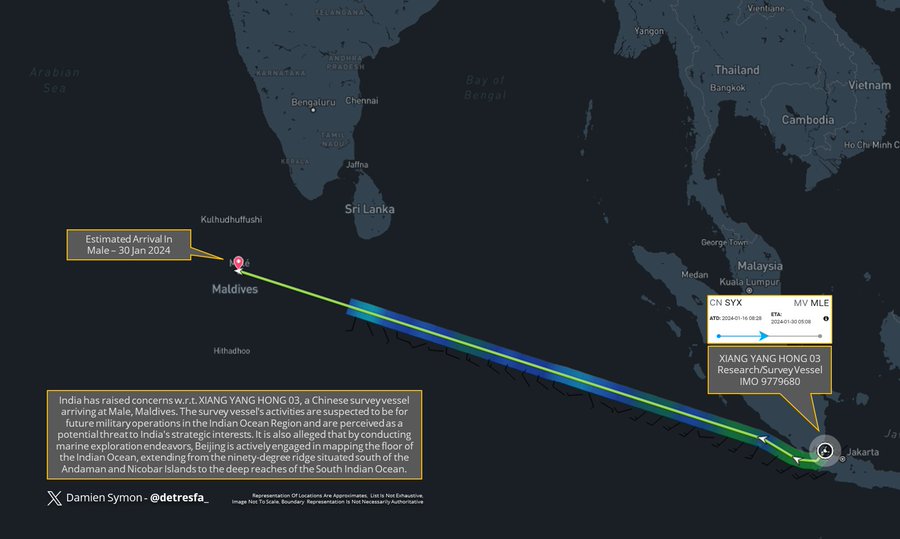Table of Contents
Introduction
Chinese ships deployment for research purposes in the Indian Ocean region has alarmed India; this development coincides with ongoing hostilities between India and the Maldives regarding the stationing of Indian troops in the region.
Based on reports from maritime tracking portals and Open Source Intelligence (OSINT) observers, the Chinese research vessel Xiang Yang Hong 03 is heading towards the Maldives as it enters the Indian Ocean. Although they did not comment on the development, official sources acknowledged it. Male is a notable destination in light of Sri Lanka’s ban on foreign research vessels and the ongoing tensions between India and the Maldives over Indian troops stationed there.

The coordinates of the Chinese ocean research vessel Xiang Yang Hong 03 were added to a social media post by OSINT handle @detresfa on the platform ‘X.’ The post stated that the vessel is expected to conduct an ocean survey operation in the Indian Ocean Region, causing concern in India.
One Indian official source stated, “This is routine movement,” without providing any additional details.
Chinese research vessels have been stationed in the Indian Ocean Rim (IOR) at a steadily increasing rate. The Ninety Degree East Ridge and Southwest Indian Ridge are the main deployment areas. Strong equipment on the research or survey vessels allows them to snoop around and collect a variety of data.
Sri Lanka’s Ban and Rising Tensions
In December 2023, Colombo announced a one-year ban on foreign research vessels visiting Sri Lankan waters amid repeated messages from New Delhi. It has been reported that Xiang Yang Hong 03, which was supposed to dock in a port in Sri Lanka this year, is now sailing for the Maldives.
The development follows concerns expressed by the United States and India to Sri Lankan authorities in the past few years regarding Chinese vessels visiting the island’s ports for scientific purposes.
The Vice-Minister of the International Department of the Chinese Communist Party (CCP) is visiting the Maldives later this month, and reports of the Chinese vessel’s arrival in the country coincide with his visit. Less than two weeks after President Mohamed Muizzu returned from China and completed a five-day state visit, during which he committed to elevate strategic ties with the Maldives, the CCP’s Sun Haiyan paid the Maldivian leader a call. It occurs at the same time that his administration keeps asking for the withdrawal of Indian troops from the Maldives. Mr. Muizzu set a deadline of March 15th for the withdrawal of Indian soldiers upon his return from Beijing; however, New Delhi has stated that talks are still ongoing.
Concerns Amidst Strategic Visits
This development also occurs a few days after the Maldives and India’s foreign ministers met in Uganda during the Non-Alignment Movement [NAM] summit. After the meeting, Maldivian counterpart Moosa Zameer stated on “X” that he had a “frank conversation” with External Affairs Minister S. Jaishankar. “We exchanged views on the ongoing high-level discussions on the withdrawal of Indian military personnel,” Zameer stated.
China now has over 350 navy ships, making it the largest navy in the world, up from 250 in less than ten years, according to a representative of the Indian Navy who testified before the Parliamentary Standing Committee on Defence in April 2023. Their operations have grown along with their numbers, and at any given time, five to nine ships are working in the IOR in addition to their research vessels, which can have an impact on our security, the representative said.
While international regulations permit research activities in international waters, the data generated has a dual nature, including military, and the motive of Chinese vessels has frequently seemed dubious, sometimes coinciding with India’s long-range missile test firing.
Under the cover of anti-piracy operations in the Gulf of Aden, China first made its appearance in the Indian Ocean in 2008. Since then, the nation has continuously maintained a presence in the area, occasionally sending out nuclear attack submarines (SSNs)